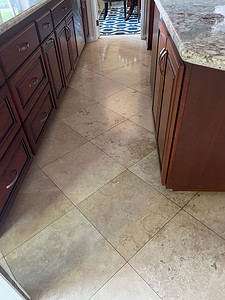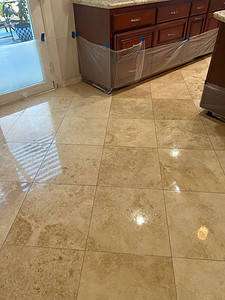Expert Travertine Floor Restoration Services
At JK Marble Maintenance, we understand the beauty and value that travertine floors add to your property.
Over time, however, these elegant floors can lose their luster and suffer from wear and tear.
Our specialized travertine floor restoration services are designed to restore the natural beauty of your flooring, extend its life, and enhance your home’s overall appeal.
Whether you’re facing dull spots, scratches, or cracks, our team of skilled professionals is here to transform your floors with honing, polishing, repairs, sealing, and grout cleaning restoration.
Why Choose JK Marble Maintenance for Travertine Restoration?
- Experience and Expertise: With years of specialized knowledge, our technicians have mastered the art of travertine restoration.
- Comprehensive Services: From minor repairs to complete overhauls, we offer a full range of services to meet all your travertine maintenance needs.
- Quality Materials and Techniques: We use only the best materials and the latest techniques to ensure your floors are beautiful and durable.
- Customer Satisfaction: Our commitment to excellence ensures every customer is satisfied with a floor that looks as good as new.
Our Travertine Floor Restoration Services:
- Honing: We remove scratches and etching from your travertine floors, creating a smooth, uniform finish.
- Polishing: Our polishing process returns the shine to your floors, enhancing their natural color and veining.
- Repairs: We expertly fill cracks and chips, restoring the integrity and appearance of your flooring.
- Sealing: Protect your travertine floors from stains and damage with our professional sealing services.
- Grout Cleaning and Restoration: We clean and restore grout lines, eliminating dirt and grime to complement your beautifully restored travertine floors.
- Travertine showers we remove mold soap scum replace grout and caulking.
What Sets Us Apart?
At JK Marble Maintenance, we focus on delivering unmatched quality and value to our customers.
We understand that every travertine floor is unique, so we tailor our services to meet your flooring needs.
Our team is dedicated to providing transparent communication, reliable service, and outstanding results that speak for themselves.
Get in Touch:
Ready to restore the beauty of your travertine floors?
Contact JK Marble Maintenance today for a consultation.
Our friendly team is eager to assess your needs and recommend the best action to revive your floors.
With our expert care, your travertine will look as pristine as the day it was installed.

Before

After
Don’t let worn or damaged travertine floors detract from the beauty of your home.
Choose JK Marble Maintenance for professional travertine floor restoration services that promise to breathe new life into your floors.
We’ve covered you, from honing and polishing to sealing and grout cleaning.
Experience the difference that expert care can make and enjoy stunning, durable floors for years.
Travertine Pros and Cons
Pros
- Natural rustic Old World visual beauty
- Budget-friendly natural stone cost
- Varied vein patterns with holes/pits
- Multiple finish options altering looks
- Matches a wide range of design styles
- Cool underfoot feel soothing sore feet
- Easy to clean with damp mopping
- Stain-resistant when properly sealed
- Durable for moderate residential traffic
- Eco-friendly, abundant natural material
- Can mimic marble or limestone aesthetics
- High skid resistance when textured
Cons
- Naturally porous, requiring frequent sealing
- Prone to etching from acidic liquids
- Finishes scratch easier than granite or quartz
- Salt and hard water residue shows noticeably
- Lippage unevenness is common, needing pads
- Patchy appearance if some holes get filled
- Natural vein color inconsistencies
- Spills are difficult to remove from holes/texture
- Not suited for hefty traffic
- Frost and freeze/thaw damage out externally
- Slight maintenance improves longevity
- Metallic ink accents contrast over time
7 Essential Tips for Flawless Travertine Restoration
Bring back the original shine of your travertine surfaces with expert restoration tips that ensure long-lasting beauty and resilience.
In the world of natural stone, travertine holds a place of honor for its timeless elegance and durability.
However, even the sturdiest materials need a little TLC to combat the wear and tear of daily life. Travertine restoration is not just about preserving the stone’s aesthetic appeal; it’s about extending its life and maintaining your property’s value.
This article delves deep into travertine restoration’s art and science, offering industry experts’ insights and practical advice.
Understanding the Beauty and Value of Travertine
Travertine, a form of limestone deposited by mineral springs, especially hot springs, has been a popular building material since the dawn of civilization. Its unique patterns, earthy tones, and versatile finishes make it a favorite for floors, walls, and countertops. Beyond its beauty, travertine’s durability and longevity are unparalleled, making it a wise investment for any property owner. But like all investments, it requires care and maintenance to sustain its value.
Why Travertine Restoration is Essential
Over time, travertine can lose its luster and suffer from scratches, etches, or stains, detracting from its natural beauty. Restoration is crucial not only for aesthetic reasons but also to prevent further damage that can compromise the stone’s integrity. Regular maintenance and timely restoration can save you from costly replacements and keep your travertine surfaces looking as splendid as the day they were installed.
Common Signs of Wear and Tear
Recognizing the early signs of damage is the first step in travertine restoration. Look out for dull spots, scratches, chips, or cracks. Stains from spills, especially acidic substances, can penetrate the stone, causing discoloration. Efflorescence, a white powdery residue, can also indicate moisture issues that need addressing.
The Restoration Process: A Step-by-Step Guide
Initial Assessment and Preparation
Before any restoration work begins, a thorough assessment is necessary to determine the extent of the damage and the best course of action. This might involve cleaning the surface to reveal hidden issues.
Cleaning: Techniques and Solutions
Cleaning travertine requires specific products to avoid damaging the stone. pH-neutral cleaners are recommended to remove dirt and grime without harming the travertine. For tougher stains, specialized poultices may be applied.
Repairing: Filling Holes and Fixing Cracks
Travertine’s porous nature means it can develop holes or cracks over time. These can be filled with a matching stone filler, then honed to blend seamlessly with the surrounding area.
Polishing: Achieving the Desired Finish
You are polishing restores the shine to travertine surfaces. The gloss level can vary depending on your desired finish, from a soft matte to a high gloss.
